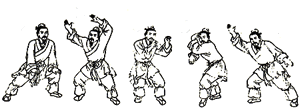
虎戏 Tiger Frolic Hŭ X́
© Valley Spirit
Qigong, Green Way Research, Red
Bluff, California, 2003-2016
By Michael P. Garofalo, M.S., All Rights Reserved.
Disclaimer
五禽戲
Frolics of the Five Animals
Bear
Tiger
Monkey
Deer
Crane
Dragon
Animal Frolics
Tiger
虎戏 Tiger Frolic Hŭ X́

Introduction
Tiger Frolic
虎戏
Tiger Frolic Hŭ X́
Ferocity
Bibliography, Links and Resources
Tiger Frolic
虎戏 Tiger Frolic Hŭ X́
Adjust San
Jiao and Strengthen Body Structure—the Effects of “Tiger Show” of Wu Qin Xi.
Chinese Health Qigong Association. 2009.
Alphabetical Index to
the Cloud Hands Website
Ancient
Way to Keep Fit. Compiled by Zong Wu and Li Mao.
Translated by Song Luzeng,
Liu Beijian, and Liu Zhenkai. Paintings by Zhang Ke Ren. Foreword by
Kumar
Frantzis. Bolinas, California, Shelter Publications, 1992. 211
pages, glossary. ISBN: 0679417893. Outstanding illustrations by Zhang Ke Ren. The
Five Animal Frolics are beautifully illustrated on pages 68-80.
Animal Frolics Qigong: Bibliography, Links,
Lessons, Resources, Quotations, History
The
Art of Shaolin Kung Fu: The Secrets of Kung Fu for Self-Defense, Health and
Enlightenment.
By Wong, Kiew Kit. Charles E. Tuttle, 2002. 215 pages. ISBN: 0804834393.
Chapter 9, pp. 102-118, Shaolin Five Animals: Training of Mind, Energy, Essence,
Speed and Elegance. Sifu Wong created a 36 Movement Five Animal Frolics form for this book.
The five Shaolin animals are the dragon, snake, tiger, leopard, and crane. VSCL.
Autumn (Fall): Poems,
Quotes, Sayings, Lore
The Bear Frolic: Bibliography, Research, Notes, Lessons
Chinese Healing Exercises: The Tradition of Daoyin. By Livia Kohn.
University of Hawaii Press, 2008. 268 pages. ISBN:
0824832698. History of Daoist health practices. Five Animal Frolics,
pp. 57-70.
Chinese Health Qigong:
Five Animal Frolics for Beginners
Instructional DVD by Master Jesse Tsao. Tai Chi Healthways, San Diego, 62
minutes. Creaded by Professor Yu Dinghai for the Chinese Health Qigong
Association.
Chinese Shamanic Tiger Qigong: Laohu Gong
Instructional DVD by Master Zhongxian Wu. St. Paul, Minnesota, Dragon Door
Publicatons, 2006. Instructional DVD, NTSC Format, 65 minutes. UPC:
872432000275. VSCL.
Cloud Hands Website: Qigong and Taijiquan
Correspondences and Alchemical Associations of the Tiger
Correspondences and Alchemical Associations of the Animals of the Five Animal
Frolics Qigong
The Crane Frolic:
Bibliography, Resources, Links, Lessons, Notes
Daoyin, Qigong, Chi Kung,
Yangsheng Gong: Bibliography, Links, Resources, Lessons, Lore
The Deer Frolic:
Bibliography, Lessons, Links, Resources, Notes, Lore
Dragon and Tiger Medical Qigong: Health and Energy in Seven Simple Movements.
By Bruce Frantzis. 245 pages. North Atlantic Books, Berkeley,
California, 2010. ISBN: 9781556439216. VSCL.
The Dragon Frolic: Bibliography, Links, Resources, Lessons, Notes, Lore
Drawing Silk: Masters' Secrets for Successful Tai Chi Practice. By
Paul B. Gallagher. Third Edition. Fairview, North Carolina, Total Tai Chi, 2007,
1988. 245 pages. ISBN: 9781419663127. The Five Animal
Frolics are covered on pp. pp. 214-215.
The Effect
of Precaution against Sub-health of the Health Qigong Wu Qin Xi.
Chinese Health Qigong Association. 2008.
Eight Section Brocade
Qigong By Michael P. Garofalo. History and purpose of
this popular chi kung practice. Descriptions for each of the eight
movements, health benefits, comments, variations, extensive links and
bibliography, resources, quotations, animated .gif photographs of the movements,
and charts. This file is updated
on a regular basis as I add new material, links, notes, and resources. A.K.A: Baduanjin, Pa Tuan Jin, Eight Silken
Treasures, Ba Duan Jin, Pal Dan Gum, Ba Duan Gin, Pa Tin Kam, Otto Pezzi di Tesoro, Acht Delen
Brokaat,
Les Huit Exercices del la Soie, Eight Silken Treasures, Brocade Qigong, Wudang
Brocade Qigong, Silk Treasures Qigong, First Eight Buddha Lohan Hands.
The Essence of Tai Chi Chi Kung: Health and Martial Arts. By Yang Jwing-Ming,
Ph.D.. Jamaica Plain, Massachusetts, YMAA Publication Center, 1990. Glossary,
appendices, index, 148 pages. ISBN: 0940871106. VSCL.
The
Essential Book of Traditional Chinese Medicine. By Liu Yanch
Five Animal Frolic, Part I. Instructional VHS/DVD, 120 minutes, by
Shifu Jiang Jian-ye. "Traditional Han Dynasty, Five Animal Frolic, Part
I."
Five Animal Frolic, Part II. Instructional VHS/DVD, 120 minutes, by
Shifu Jiang Jian-ye. "Traditional Han Dynasty, Five Animal Frolic, Part
II."
Five
Animal Frolic Handout. A set of attributions and associations for each
Frolic. From Three Treasures Tai Chi.
Five Animal Frolics. An instructional DVD by Kenneth Cohen.
© 1990. Website:
www.qigonghealing.com
Lecture and demonstration of each Frolic set. VSCL.
Five Animal Frolics.
Instructional videotape by Michael Gilman. 60 minutes VHS or
DVD. Five
Animal Frolics "An ancient form of Chi Kung, probably having strong
influence on the development of Tai Chi Chuan. These easy to do, fun to practice
movements are very complete for physical conditioning and internal health and
well being. Especially valuable for the internal organs. Michael takes you
through and explains these Five Animals in a simple easy to learn way. 60
minutes, produced for television."
Five Animal Frolics.
Instructional DVD by Paul Gallagher. 95 minutes VHS. "Five Animal
Frolics #1: China's Earliest set of Internal Exercises, based on the
Life-Enhancing Movements of the Crane, Bear, Monkey, Deer, and Tiger.
A complete invigorating fitness system for both body and mind which
generates energy and mental poise without ever causing strain on the heart or
joints. Many qualities of T'ai Chi, but much easier to learn for young or old.
This Video of the Frolics contains complete, step-by step descriptions and
explicit instructions for each movement. Excellent audio and video quality,
close-ups and multiple angles enable you to see and refine every detail of your
movement. Run-time is approximately 95 minutes; cost is $49."
Five Animal Frolics: A Form Workbook. A Complete Qigong Program for High Energy, Vitality and
Well Being. By John Du Cane. St. Paul, Minnesota, Dragon
Door Publications,
2002. Second Edition, 2002. 121 pages. Spiral bound
notebook. 100 photographs. No ISBN. VSCL.
Five Animal Frolics: Google Search
The Five Animal Frolics: A Practical and Workable Qigong Method. By
John Du Cane.
Five Animal Frolics
Qigong. Authentic Eastern Health. Instructional DVD, 60 Minutes.
Master Ping Zhao.
Five Animal Frolics Qigong: Bibliography,
Resources, Lessons, Links, Quotations, History. By Michael Garofalo.
Five Animal Frolics Qigong.
By Michael Winn. Includes instruction on Inner Smile and Six Healing
Sounds. Audio CDs, DVDs, books. VSCL.
Five Animal Sports Qigong. Instructional DVD, 180 minutes, by Dr.
Yang, Jwing-Ming and Kathy Yang.
YMAA Publication Center, 2008. ASIN:
B0018OZFOS. VSCL.
Green Way Research.
Red Bluff, California.
Hatha
Yoga: The Hidden Language; Symbols, Secrets and Metaphor. By Swami
Sivananda
Radha. Foreward by B.K.S. Iyengar. Spokane, Washington, Timeless
Books, 1987,
1995. Index, 308 pages. ISBN: 0931454743. MGC. A
wonderful book filled with lore,
myths, symbols, stories, and metaphors about various yoga postures. Yoga
postures that embody
aspects of birds (pp. 180-225) include the Swan (Hamsasana),
Crane (Bakasana), Eagle
(Garudasana), Peacock (Mayurasana), and Cock
(Kukkutasana).
History of
the Five Animal Frolics
The
Magician's Companion. A Practical and Encyclopedic Guide to Magical
and Religious Symbolism. By Bill Witcomb. St. Paul, Minnesota, Llewellyn
Pubs., 1993. Appendices, resources, 577 pages. ISBN: 0875428681. VSCL.
The
Magic of Shapeshifting. By Rosalyn Greene. Red Wheel Weiser,
2000.
258 pages. ISBN: 1578631718. According to Ms. Greene the most
common
animals people shift into are the wolf, fox, cat and bear.
Magic Pearl
Qigong: A Tai Chi Medicine Ball Exercise Routine and Meditation Technique.
Developed by Mike Garofalo.
Massage - Self-Massage,
Patting
The Monkey Frolic:
Bibliography, Links, Resources, Lessons, Notes, Lore
Power Qigong: The Bear and Tiger Frolics By John Du Cane. St. Paul, Minnesota,
Dragon Door Publications,
2000. Instructional DVD, 48 minutes. Anti-Aging
Series. ISBN: 0938045210. Website:
www.dragondoor.com. VSCL.
Qigong Essentials for Health Promotion. By Jiao Guorui. Beijing,
China Reconstructs
Press, 1988. A lengthy description of the Five Animal Frolics can be found
on pages
190-236. VSCL.
Relaxation (Sung, Song, Shoong),
Effortless Action, and
Qigong Links,
bibliography, quotes, and notes.
By Mike Garofalo.
Six Taoist
Healing Sounds Research by Mike Garofalo.
The
Spirit of the Five Animals: Shaolin Martial Arts. By Tak Wah Eng.
Bo Law Kung Fu Federation, 2005. 171 pages. Simple descriptions,
with black and white photographs, for each animal form: Dragon, Tiger,
Leopard, Crane and Snake. VSCL.
The
Spiritual Legacy of the Shaolin Temple: Buddhism, Daoism, and the
Energetic Arts.
By Andy James. Foreword by Dr. Jerry Alan Johnson.
Summerville, MA, Wisdom
Publications, 2004. 179 pages. I SBN: 0861713524. VSCL.
Spontaneous Five
Animal Play Qigong (Zifa Wuqinxi Donggong).
Compiled and readjusted by Liang
Shifeng who is a major Qigong master from a southern province of China, called
Guangdong in the early 1980s.
Staff Weapons: Bibliography, Links,
Resources, Lessons
Sun Lu Tang's
Internal Martial Arts: Baguazhang, Xingyiquan, Taijiquan, and Qigong.
Bibliography, Links, Quotes, Resources, Instructions.
Shen-nong
Limited: History of Chinese Medicine
Standing Meditation
(Zhan Zhuang)
Taoist
Qigong for Health and Vitality. A Complete Program of Movement,
Meditation,
and Healing Sounds. By Sat Chuen Hon. Foreword by Philip
Glass. Boston, MA, Shambhala Pubs. Inc., 2003. Notes, 174 pages. ISBN: 1590300688.
The healing sound for the Heart in this book is "Ho" and is described on pp.
71-83. VSCL.
Tiger Frolic.
UTube Video, 1:34 minutes.
Performed by Anson Rathbone, 2007. As taught by
Deguang at NESA's Medical Qigong Class.
Tiger Frolic. UTube Video, 4:33
minutes. Peformed by Master Howard Choy.
The Tiger Frolic:
Bibliography, Links, Resources, Lessons, Notes
Tiger Frolics UTube, 7:26
minutes.
Tiger Frolics
Walking by Deborah Davis at Kripalu
Valley Spirit Qigong,
Red Bluff, California. Instructor: Mike Garofalo, M.S.
Video Demonstrations Online
Five Animal Frolics.
Demonstration by Master Jesse Tsao. UTube, 6:46 minutes.
Five Animal
Frolics Video Demonstrations
Five Animals Qigong.
Demonstration by Master Xiao. UTube, 9:46 minutes.
Tiger Frolic.
UTube Video, 1:34 minutes.
Performed by Anson Rathbone, 2007. As taught by
Deguang at NESA's Medical Qigong Class.
Tiger Frolic, Five
Animal Frolics, Demonstration by Master Howard Choy, UTube Video, 4:33 Minutes.
Tiger Frolics UTube, 7:26
minutes.
WuDang Five Animals Qigong.
UTube, 6:30 minutes.
Vital Breath of the Dao: Chinese Shamanic Tiger Qigong (Laohu Gong)
Vital Breath of the Dao: Chinese Shamanic Tiger Qigong (Laohu Gong).
Demonstrated and taught by Master Zhongxian Wu. Instructional DVD.
65 minutes running time. Available from
Dragon Door Publications, 1-800-899-5111. DVD
# 031. VSCL.
The Way
of Qigong: The Art and Science of Chinese Energy Healing. By Kenneth
S. Cohen.
Foreword by Larry Dossey. New York Ballantine Books, 1997. Index,
notes, appendices, 427 pages. ISBN: 0345421094. One of my favorite books:
comprehensive,
informative, practical, and reasonable.
Ways of Walking: Poems,
Quotes, Sayings, Bibliography, Links, Lessons, Resources
Wild Goose Qigong: Links, Bibliography, Quotes, Notes
Wudang Five Animal Qigong - The Tiger
Wudang Five Animal Form.
Instructional DVD. Featuring Master Zhong Xue Chao..
Introductory video, 5:32 minutes. Instruction over-dub voice in
English. This DVD include 5 forms of Tortoise, Crane, Snake, Tiger, and
Dragon. All 5 animal's complete demonstration, introduction and teaching.
List of movements.
Wudang Five Animal Regimen
UTube Video, 5:53 minutes.
Wu Qin Xi Qigong.
UTube Video, 6:30 Min.
Wu Qin Xi. By
Hu, Yao-zhen
(1879-1973). Hong Kong, Xin Wen Shu Dian,
n.d..
Wu Qin Xi.
Chinese Health Qigong Assocation.
Wu Qin Xi (Five Animal Frolics): Chinese Health Qigong. Compiled by
the Chinese Health Qigong Association. Beijing, Chine, Foreign Languages
Press, 2007. 102 pages, includes an instructional DVD. ISBN:
9787119047799. VSCL.
"In 2001 the Chinese government showed great interest in regulating the Qigong
movement. The State Sport General Administration of China founded the Chinese
Health Qigong Association, as a mass-organization to popularize, spread and
research Health Qigong in cooperation with the Peking Sport University. In 2003
the organization presented the newly developed four Health Qigong Exercises on
the base of excellent traditional Qigong, including:
Ý Jīn
Jīng (tendon-changing classic),
Wu Qin Xi (frolics of five animals 五禽戲),
Liu Zi Jue
(the art of expiration in producing six different sounds),
Ba Duan Jin (eight excellent movements), to fit the people's needs of
promoting their health and body, and to develop traditional Chinese national
culture further. The Chinese Health Qigong Association is a member of the
All-China Sports Federation. During the process of developing the
exercises, strictly scientific research methods have been followed. Primary
experiments took place under supervision of Traditional Chinese Medicine, Modern
Medicine, Psychology, Athletic Science and other related subjects. The Four
Health Qigong Exercises can be seen as the essences from the related Qigong in
various schools, inherited and developed traditional Chinese national culture.
The new Health Qigong represented by the Chinese Health QiGong Association is
breaking with the old tradition of family-styles and close teacher-student
relation. It is hoped that the new standardisation is supporting the
international spread of Qigong in the western hemisphere. Starting in
September 2004 the "Health Qigong Magazine" became the association magazine of
the CHQA. It is the only national health qigong publication in China; edtited
through China Sports Press. After the successful 1st International Health
Qigong Demonstration and Exchange in 2005 the CHQA organized in August 2007 the
2nd International Health Qigong Demonstration and Exchange in Peking including
an international competition and the first Duan examination on Health Qigong. At
the same time, the 2007 International Symposium on Health Qigong Science was
organized where important scientific studies were made public."
- Wikipedia
Wu Qin Xi,
Five Animal Frolics Qigong: Bibliography, Resources, Lessons, Links,
History. By Michael P. Garofalo, M.S.
Wuqinxi: Five Animal Frolics Medical Qigong. By Dr. Jay Dunbar,
Ph.D. "Wuqinxi Qigong is attributed to the physician Hua T'o. An
excellent and delightful lifelong exercise, the Frolics utilize deep, smooth,
breathing matched to movements that mimic the crane, bear, monkey, deer and
tiger. The aim is to enhance the flow of qi (life energy), harmonize the five
elements (fire, water, earth, wood, and metal), strengthen the internal organs,
nerves, muscles, and bones, prevent and cure diseases, improve the health and
vitality of body, mind, and spirit, and prolong life. Paul Gallagher, who
learned it from Ken Cohen, taught us the basic set in 1988. The author and his
wife, Kathleen Cusick, augmented the set as research and insight suggested. The
book contains two five-color meditations from Master Jou Tsung Hwa, and
directions for movement, breathing, visualizations and suggested health effects
for the 42 exercises. 48 pp."
Xing Yi Quan (Hsing
I Chuan) makes use of Twelve Animals.
Yangsheng Gong, Daoyin,
Qigong:
Bibliography, Links, Resources, History, Lessons, Guides, Quotes
Yi Jin Jing Qigong
(Muscle/Tendon Changing Qigong): Bibliography, Links, Resources, Lessons.
By Mike Garofalo.
Yuli Qigong. By
Jeff Smoley. Wujigong, Zhan Zhuang, 5 Animal Frolics, Jade Power Qigong,
and Eight Section Brocade. Jeff borrowed my
disclaimer.
Zhan Zhuang, Standing Meditation - Standing Like a Tree - Meditation and Qigong
Postures,
Routines, Names of Movements
Tiger Frolic
虎戏 Tiger Frolic Hŭ X́
Anson Rathbone, Tiger Frolic UTube
1. Tiger Looks Around
2. Scratch, Scratch, Lunge
3. Big Lunge
4. Circle Back, Reach and Tear
Tiger Frolic. UTube Video, 1:34 minutes. Performed by Anson Rathbone, 2007. As taught by Deguang at NESA's Medical Qigong Class.
Kenneth Cohen, 5 Animal Frolics
1. Stepping forward side to side, alternating
legs, both arms reach forward with tiger claw hands forward with each step
2. Same as 1, tiger claw hands first forward then drop down
3. Corner stepping, add lung, same as 2
4. Corner stepping, lung, same as 2, repeat longer lung, claws forward
then down
5. Tiger Climbs the Mountain: Forward stepping, one arm claws up and
down, other arm reaches back
Five Animal Frolics. An instructional DVD by Kenneth Cohen. © 1990. Website: www.qigonghealing.com Lecture and demonstration of each Frolic set. VSCL.
Jiao Guorui, Qigong Essentials for Health Promotion
1. Tiger Footwork
2. Tiger Power
3. Coming Out of the Tiger's Den
4. Preying Movements
5. Tiger Combat
Jiao Guorui, Qigong Essentials for Health Promotion, 1988. The Tiger Frolic exercises are discussed on pages 214-220. This set features walking forward as each exercise is done.
Yajun Zhuang, Five Animal Frolics
1. Preparation Position
2. Tiger Gaze
3. Tiger Out of Cave
4. Tiger Gaze Around
5. Tiger Pounce on Food
Five Animal Frolics by Master Yajun "Thomas" Zhuang
Wudang Five Animal Qigong
In Chinese traditional culture, the tiger was the symbol of power and
unruliness. In the five elements, the tiger belongs to soil. Practicing the
regimen often can cultivate the spleen and stomach, strengthen the bones and
muscles.
1.Starting position
2. Guarding the breath into the pubic region
3. The tiger washing the hands and face
4. The tiger crouching down to listen to the wind
5. The tiger attacking at the prey
6. The tiger standing there still to look around
7. The tiger swallowing the prey
8. The tiger turning back the head
Closing position
Lessons, Instructions, Suggestions,
Comments
Tiger Frolic
虎戏 Tiger Frolic Hŭ X́
There is no one common set of movements for the Tiger Frolics Qigong. Each
Qigong teacher repeats what they first learned, or creates their own set of
Tiger Frolic movements from the dozens of different movement sets available.
Variety is a hallmark of all Animal Frolics movement
sets. Nobody really knows the exact movements of the original Tiger
Frolics set created by Hua Tuo in the second century CE. Most Tiger
Frolics sets have 3 to 5 movements in the set. My own version of the Tiger
Frolics movements are taken from a number of different Tiger Frolics Qigong
sets, or are created on my own, and the sources for each movement are cited
below.
All Tiger sets feature the hands in a Tiger Claw: open fingers, rounded, tensed, as if the tiger or cat were reaching with their claws extended. The eyes are often focused and "fierce" in intention. Stepping into lunge postures are a common feature of Tiger Frolic movement sets. The Tiger Frolics emphasize muscular force and tendon power per Kenneth Cohen.
Safety Considerations: Always sensibly adjust and modify any Tiger Frolic movement to suit your level of physical conditioning, your flexibility, and any injuries you may be dealing with. Make adjustments according to your age. Pay attention to how you feel and listen to what your body is telling you. Don't do some suggested exercises as necessary. Avoid injuries and setbacks by knowing your own limitations. Here is some more safety advice in my Disclaimer.
1. The Tiger Lunges and Attacks
Feet together. Stand up straight. Arms at
sides. [1a]
Bring hands to waist level with tiger claw hands (fingers open and curled).
Step out to right side at a 45 degree angle with the right leg. [1b] Step into a
high lunge posture. [1c]
As the right foot lifts and steps to the side [1b], draw both hands up the body to
above the head, lift the head, circling both arms up and down. [1b]
As the right foot comes to the floor (ground), both hands, separated by a foot or so, claw
downward to about waist level. [1c]
Draw the arms back to the waist (as if pulling the captured prey close to your
Tiger body) [1d] as the right foot is drawn back to beside the left foot.
[1e]
Repeat this movement on the right side 4 to 8 repetitions.
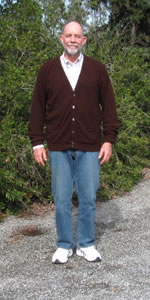 |
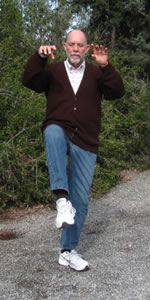 |
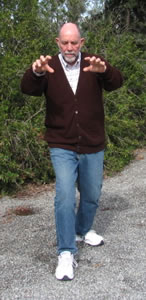 |
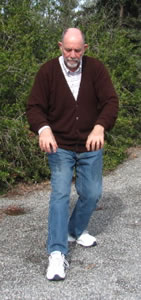 |
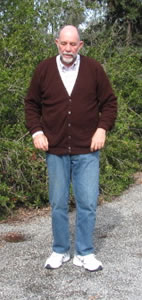 |
| 1a | 1b | 1c | 1d | 1e |
Do the same movement to the left side.
Step out to left side at a 45 degree angle with the left leg. Step into
a high lunge posture.
As the left foot lifts and steps to the side, draw both hands up the body to
above the head, lift the head, circling both arms up and down.
As the left foot comes down to the floor (ground), both hands, separated by a foot or so,
claw downward to about waist level.
Draw the arms back to the waist (as if pulling the captured prey close to your
Tiger body) as the left foot is drawn back to beside the right foot.
Repeat this movement on the left side 4 to 8 repetitions.
Movement source citation: Tiger Frolic #3, Big Lunge. UTube Video, 1:34 minutes. Performed by Anson Rathbone, 2007. As taught by Deguang at NESA's Medical Qigong Class.
2. The Tiger Crouches, Raises, Lunges, and Attacks
From a standing position, with the feet at shoulder
width, draw your loosely clenched fists up to your upper chest.
Bend forward from the waist, extend the arms forward, make tiger claws with
palms down. Bring the head down to the level of the hips. Keep the
back as straight as possible. Bend the knees slightly.
Draw the arms back to the knees as you squat down low, look downward.
Draw both arms up the body to your upper chest, fingers loosely clenched,
gradually stand up and lean back as you look up. Arms are draw up close to
the body as as you
stand up.
Bring both arms up a to ears and then above your head, and then forward and down as you step forward with the
left foot into a short lunge posture. The hands form a tiger claw as they
come down.
Step back with the left foot to a centered position and bring the arms to the
sides. Imagine dragging the captured prey back to the Tiger's body before
the killing bite to the prey's neck.
Repeat exercise but step out to the right side.
Movement source citation: Tiger Frolic, Movement
2, Seizing the Prey, pp. 33-41.
Wu Qin Xi (Five Animal Frolics): Chinese Health Qigong. Compiled
by the Chinese Health Qigong Association. Beijing, China, Foreign
Languages Press, 2007. 102 pages, includes an instructional DVD.
ISBN: 9787119047799. VSCL.
Quotations
Tiger Frolic and Tiger Lore
虎戏 Tiger Frolic Hŭ X́
"The Tiger Play is to imitate the shape and movement of
a tiger. The features of a tiger are its ferocity, strong body, and good at
jumping and scratching. The most important element in the Tiger Play is to
imitate the awe inspiring attitude of a tiger. Its spirit is shown in its eyes
and its awesomeness comes out of its craws. It gazes with raged eyes and moves
like wind. It twists its waist with force, wags head and swings tail, and
vibrates its body. In practice the Tiger Play, you need to focus your attention
on the "Life Gate" acupoint. The "Life Gate" is where the "Yuan Yang" resides.
It is the sea of sperm and blood, the root of "Yuan Qi", and the tabernacle of
water and fire. If you focus your attention on the "Life Gate" during practice,
it will benefit your kidney and strengthen your waist, build your bones and
produce marrows. It can also open the Jen (conception) and Du (governing)
meridians to get rid of wind evils. The Tiger Play is suitable for curing the
following diseases: clogged meridians, numbness caused by partially blocked Qi
and blood circulation, pain in pelvis nerves, waist and back pain, infected
spine, high blood pressure, and infected Du meridain."
- Master Yajun “Thomas” Zhuang,
Five Animal
Frolics
"The tiger is the second animal in the five animal set
and one of the most powerful. The tiger is an animal that is know for its
speed, agility and external strength. Training under this form will
develop the bones, joints, and tendons as it requires intricate coordinated
movements. The body is trained in the manner where it holds in twisting
stances to develop a coil like exertion. This centers the body to the
ground and develops the legs to become more graceful yet deadly. This form
is perhaps the most physically challenging of all the forms. Mastery of
this form will strengthen the forearms, legs, torso and hands."
- Tak Wah Eng, The Spirit of the Five Animals, p. 101.
"Legend has it that when Bodhidharma arrived at Shaolin [circa 525 CE], the
monks practicing there were frail and sickly and fell asleep when they tried to
meditate. He believed that strong bodies and good health would aid their
spiritual practices and supposedly taught them three qigong exercises that are
still practiced: The Muscle and Tendon Changing Classic (yi
jin jing), Bone-Marrow Washing (xi sui jing), and the Eighteen Lohan Qigong
(shi ba lo han gong). There is some disagreement
as to whether these exercise were from Indian yogic or Chinese qigong traditions
and whether they originated in Bodhidharma's time or later.
The movements of the original Eighteen Lohan Qigong (a lohan,
or arhat, is one who has reached the stage of nirvana) became the basis of
martial training and in time developed into a more complex system of 72
movements. By the time of the Mongol Yuan dynasty (1279-1368), these has
expanded to 170. These movements were expressed in the Five Styles, which
drew upon the fighting styles, characteristics, and spirits of different
animals. The dragon, tiger, leopard, snake and crane (or cock) styles
represented the training of spirit, bones, strength, qi, and sinews
respectively. It was said that to truly master this "mimic boxing"
(imitating various animals), the human ego had to be set aside, which is also
one characterization of the goal of Chan Buddhism."
- Andy James, The Spiritual Legacy of Shaolin Temple, p. 31
"Usually, the Chinese call the tiger Laohu -literally meaning "old
tiger," regardless of the tiger's age. Chinese character Lao for old is a
symbol for wisdom and shamanic power. The tiger is the spiritual animal of the
western direction and is related to the Queen Mother of the West. The Queen
Mother of the West is a condensation of the Subtlest Vital Breath of the Western
Essence from the Vital Breath of the Dao of the Original Chaos.
The universal rhythm of the Dao can be found in the microcosm of the Lung. From
a classical Chinese medicine perspective, we will never get sick if we can
maintain Zhengqi in the body. Physically, Zhengqi is represented most strongly
by the Lung, which prevents Xie (evil) Qi from invading the body. Here, Zheng can
be translated as correct or upright. In contrast to Zheng, Xie can be translated
as incorrect or tilted. Therefore, Xieqi includes all the factors, such as
emotions, food, weather, habits, attitude, posture, or trauma, that may cause
illness. One of the functions of Lung is to govern and energize all the
meridians of the body. Strong Lung Qi helps us maintain wellness. We will be
more susceptible to illness if the Lung Qi is weak. Thus, in Chinese medicine,
the tiger is the spiritual animal of Lung and stands for the essential Lung Qi and
vital breath.
The Chinese
Shamanic Tiger Qigong form is based on symbolic power-the essence of Chinese
Shamanism-and has both medical and martial arts applications. The tiger form is
the story of energy circulation from west to east, the movement of the Dao
itself, as the symbolic power of the tiger communicates directly with the Dao.
There are twenty-four movements in the form. Each individual movement is a
seasonal connected to the Universal energy to help one to improve one's life.
Through regular practice of the tiger form, one will strengthen one's Lung
function and tonify one's Zhengqiand increase the harmonizing Qi of the whole
body. In this way, one will be able to attune the personal Qi to resonate with
the Universal Qi, to discover one's true potential nature and breathe with the
Dao."
-
Vital Breath of the Dao: Chinese Shamanic Tiger Qigong
(Laohu Gong).
By Master Zhongxian Wu, pp. 106-115.
"The 5 Animal Frolics (五禽戲, Wu Qin Xi) is a complete
qigong system, and the most ancient qigong system still practiced today. According to Kenneth Cohen, author of The Way of Qigong,”As story has it (Daoist
Legend) Hua Tuo [110-207 AD/CE] received this text as well as instruction in
Five Animals from two recluses living in a cave on Mount Gong Yi.” The “more
recent” teachers whom are credited with spreading qigong (and Five Animal
Qigong, in particular) are Madame Guo Lin (1906-1984) and Feng Zhiqiang (who
learned this from his teacher, Hu Yao-zhen)*. The series of exercises that
comprise the Five Animal Frolics not only help to keep the body sprightly and
strong, but it engages both the mind and spirit as well. The Five Animal
Frolics help to great depth to your practice by allowing your body to
communicate in different ways."
-
Creating Joyous Practice with the Five Animal Frolics
Information,
Facts, Lore, Artwork
Tigers
虎戏 Tiger Frolic Hŭ X́
All species of tigers are endangered.
Domestic house cats sleep an average of 13 to 16 hours each day. A tiger will spend from 16 to 20 hours of each day doing very little apart from lying in the shade.
"The tiger (Panthera tigris) is the largest
cat species,
reaching a total body length of up to 3.3 metres (11 ft) and weighing up to
306 kg (670 lb). It is the third largest land carnivore (behind only the
Polar bear and the Brown bear). Its most recognizable feature is a pattern of
dark vertical stripes on reddish-orange fur with lighter underside. It has
exceptionally stout teeth, and the canines are the longest among living felids
with a
crown height of as much as 74.5 mm (2.93 in) or even 90 mm (3.5 in). In
zoos, tigers have lived for 20 to 26 years, which also seems to be their
longevity in the wild. They are territorial and generally solitary but social
animals, often requiring large contiguous areas of habitat that support their
prey requirements. This, coupled with the fact that they are indigenous to some
of the more densely populated places on Earth, has caused significant conflicts
with humans.
Tigers once ranged widely across
Asia, from
Turkey in the
west to the eastern coast of Russia. Over the past 100 years, they have
lost 93% of their historic range, and have been extirpated from southwest and
central Asia, from the islands of Java and Bali, and from large areas of
Southeast and Eastern Asia. Today, they range from the Siberian taiga to open
grasslands and tropical mangrove swamps. The remaining six tiger subspecies have
been classified as endangered by
IUCN. The global population in the wild is estimated to number between 3,062
to 3,948 individuals, down from around 100,000 at the start of the 20th century,
with most remaining populations occurring in small pockets that are isolated
from each other. Major reasons for population decline include habitat
destruction, habitat fragmentation and poaching. The extent of area occupied by
tigers is estimated at less than 1,184,911 km2 (457,497 sq mi), a 41%
decline from the area estimated in the mid-1990s.
Tigers are among the most recognizable and popular of
the world's charismatic megafauna. They have featured prominently in ancient
mythology and folklore, and continue to be depicted in modern films and
literature. Tigers appear on many flags, coats of arms, and as mascots for
sporting teams. The
Bengal
tiger is the national animal of Bangladesh and India."
- Tiger - Wikipedia
"I have studied many philosophers and many cats.
The wisdom of cats is infinitely superior."
- Hippolyte Taine
"Tigers live alone and aggressively scent-mark large
territories to keep their rivals away. They are powerful nocturnal hunters that
travel many miles to find buffalo, deer, wild pigs, and other large mammals.
Tigers use their distinctive coats as camouflage (no two have exactly the same
stripes). They lie in wait and creep close enough to attack their victims with a
quick spring and a fatal pounce. A hungry tiger can eat as much as 60 pounds (27
kilograms) in one night, though they usually eat less. Despite their
fearsome reputation, most tigers avoid humans; however, a few do become
dangerous maneaters. These animals are often sick and unable to hunt normally,
or live in an area where their traditional prey has vanished. Females give
birth to litters of two to six cubs, which they raise with little or no help
from the male. Cubs cannot hunt until they are 18 months old and remain with
their mothers for two to three years, when they disperse to find their own
territory."
-
Bengal Tiger - National Geographic
"The domestic cat (Felis catus or Felis
silvestris catus) is a small, usually furry, domesticated, carnivorous
mammal. It is often called the housecat when kept as an indoor pet, or simply
the cat when there is no need to distinguish it from other felids and felines.
Cats are the most popular pet in the world, and now found
almost every place where people live. Cats are valued by humans for
companionship and ability to hunt vermin and household pests.
Cats are similar in anatomy to the other felids, with strong,
flexible bodies, quick reflexes, sharp retractable claws, and teeth adapted to
killing small prey. Cat senses fit a crepuscular and predatory ecological niche.
Cats can hear sounds too faint or too high in frequency for human ears, such as
those made by mice and other small game. They can see in near darkness.
Like most mammals, cats have poorer color vision and a better sense of smell
than humans.
Despite being solitary hunters, cats are a social species,
and cat communication includes the use of a variety of vocalizations (meowing,
purring, trilling, hissing, growling and grunting) as well as pheromones and
types of cat-specific body language.
Since cats were cult animals in ancient Egypt, they were commonly
believed to have been domesticated there, but there may have been instances of
domestication as early as the Neolithic. A genetic study in 2007 revealed
that domestic cats have descended from
African wildcats (Felis silvestris lybica) c. 8000 BCE, in the Middle
East."
- Domesticated and Feral Cats -
Wikipedia
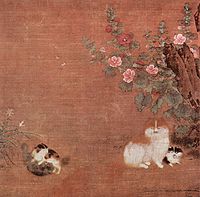
Cats in the Garden,
by Mao Yi, 12th century China
Cultural
Depictions of Cats
Cats and Dogs in the Garden: Quotes, Sayings, Lore
"With the image of the lion in mind, the
Egyptians built the Sphinx, a huge effigy of the Sun God, with the body of a
lion and the head of a Pharaoh, and they also worshipped the goddess Sekhmet,
who with the head of a lion (see picture) was the goddess of war, who descended
to the earth to destroy the enemies of Ra, and was known as the Eye of Ra.
Amongst the list of Egyptian feline goddess we find Mau, a personification of Ra
as a cat (Mau being the ancient Egyptian word for cat); Tefnut, a lion
headed goddess whose name means Moisture and represents one of the most
primeval forces of creation; and Mafdet, a goddess of protection. In an Ancient
Egyptian spell which repels snakes, the protection of Mafdet is invoked: 'O
cobra, I am the flame which shines on the brows of the Chaos-gods of the
Standard of Years. Begone from me, for I am Mafdet!'
However, the domestic cat was specifically claimed to be
under the protection of Bast. Bast, like Sekhmet was often said to be the
daughter of Ra, and she was the protector of cats and those who took care of
cats; her gifts were joy and pleasure. Her cult was centered in the city of
Bubastis (called Per-Bast, or House of Bast, by the Egyptians), where,
once her temple stood. The Greek historian, Herodotus said "there is no
temple more beautiful than that of Bubastis". Bubastis also housed a
necropolis where hundreds of mummified cats were buried. She also had an annual
festival, which seems to have been one of the most popular in the whole of
Egypt, accompanied by loud music and chanting. She is often represented either
as a woman with a cat's head, or as a cat. The significance of Bast can only be
understood by comparing her to Sekhmet. Indeed, there is evidence that the
Egyptians viewed them as aspects of the same divine force - Sekhmet being the
violent aspect of the divine sun, and Bast being its gentler aspect."
- The Magic Paw -
Cats and World Mythology
"In China, the tiger is considered the
King of All Beasts and represents
powerful energy. Further, the tiger is associated with Tsai Shen Yeh, the
Chinese God of Wealth, and this god is usually seen sitting on a tiger in Asian
art. Asian lore considers the tiger the
protector of the dead, and will often be seen near graves as a mark of
protection, assuring peace for those who have passed. The tiger is
associated with power, yang energy, royalty, protection, generosity,
illumination, and unpredictability.
In ancient Chinese myth there are Five Tigers that hold the
balance of cosmic forces in place and prevent the universe from collapsing into
chaos. The White Tiger rules the Fall season and is the governor of the
Metal Element. The Black Tiger rules the winter season and is the governor
of the Water Element. The Blue Tiger rules the Spring season is is the
governor of the Earth Element. The Red Tiger rules the summer season and
is the governor of the Fire Element. The Yellow Tiger is the supreme ruler
of all the other Tigers and is associated with the sun."
-
Chinese Tiger Symbolism
"'Tiger' ('Hu') represents 'the king of the mountains'.
It is seen as powerful and full of courage and dignity. Since ancient times,
Chinese people have worshiped and honored the tiger. In China today, there are
many folk-customs and festival days involved with the tiger: people paste
pictures of tigers onto doors or windows of their houses in order to be
protected; the new-born infants are often named as "Tiger Boy" (Hu Wa) or "Tiger
Girl" (Hu Niu) with the hope of their parents that they will grow up as
vigorously as a tiger; soldiers are also called "the Tiger military officer" for
their bravery."
- The
Tiger in Chinese Rock Art
"The Tiger (
虎
), is one of the 12-year cycle of animals which appear in the
Chinese zodiac related to the
Chinese calendar. The Year of the
Tiger is
associated with the
earthly branch symbol
寅.
For example, 15 February 2010 – 2 February 2011: Year of the Metal Tiger."
- Tiger in Zodiac
Table of
Correspondences, Associations, Symbolism
Tiger Frolics
虎戏 Tiger Frolic Hŭ X́
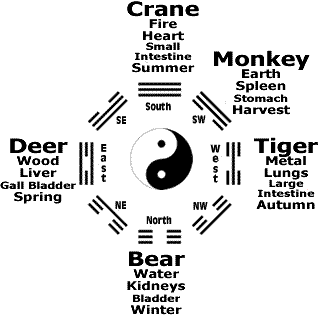
Correspondences and Alchemical Associations for the Tiger:
Attributes: Power, Courage, Ferocity, Quickness; Builds Willpower,
Develops Yang Energy
Elemental: Metal; Metal creates Water
Direction: West
Organ: Lung
Environment: Dry, mild temperatures, less humidity. Lungs cannot function
with too much moisture inside of them, e.g., drowning, congestive heart failure,
flu, pneumonia, bronchitis, etc. Air that is too hot or too cold cause
breathing problems. The cooler and dryer weather of autumn is favored.
Clean air with less smoke, smog, and other pollutants is best.
Season: Autumn
Color: White
Yin Organ: Lungs
Yang Organ: Large Intestines
Energetic Movements: Contracting, Sinking, Crouching, Leaping, Letting Go
Healing: Lungs, Bronchi, Nose and Sinus; Muscles, Tendons, Skin; Large
Intestines, Liver and Gall Bladder. The work on the lungs helps prevent
colds during the coming winter season (water).
Healing Sound: "hsssssss"
Time of Day: Lungs (3am-5am) and Large Intestine (5am-7am)
Release: Grief, Sadness
Encourage: Strength (Yang); Joy and Courage (Yin)
Associations: Harvest, Dusk, Dryness,
Body Language of Tiger or Cat: Sleeping, Purring, Clawing, Jumping,
Crouching, Stalking, Biting
The assignment of alchemical and magickal correspondences to the Tiger vary amongst practitioners of the Five Animal Frolics, qigong theorists, and Taoist Alchemists. The following authors have provided tables of correspondences: Kenneth Cohen, Franklin Fick, Mike Garofalo, Alan Graham, Livia Kohn, Joseph Morales, Ken Morgan, Nancy Seeber, Yang Jwing-Ming, and Oberon Zell-Ravenheart.
Readers should keep in mind that knowledge of these alchemical and magickal correspondences is of some usefulness to most practitioners. The true Adepts and playful Wizards will need to pay very close attention to correspondences. Theses associations have a long history in China and their meanings are part of the mental aspects of the Five Animals Frolics Daoyin practice. Daily practice of the Frolics, often outdoors, is essential to embody these cosmic principles.
A wise person will always try to understand the cosmic forces that influence and/or rule our lives: the air we breathe, the sun that warms the earth, the water that sustains all living beings, the plants and animals of our world, the human technology that makes our lifestyles possible, the ideas and values that constitute our spirit. These forces are symbolized by Air (breath, energy), Fire (sun, hearth, heat, light), Water (rain, snow, lakes, sea, ponds, wells), Wood (plants, trees, fruit, grains, food), Animals (Deer, Crane, Monkey, Tiger, Bear, Dragon, etc., domesticated animals, food, humans), Metal (technology, science, agriculture, minerals, earthly resources), Humanity (persons, family, village, state, society, culture), Spirit (mind, knowledge, wisdom, Shen, Dao), and the Unbounded (imagination, fantasy, spirits, divine, Wu, Heaven, Emptiness).
In China, the Five Elements (Phases, Processes, Cycles) are: Earth, Fire, Water, Wood, and Metal. In the West, the Five Elements (Materials, Substances, Components) are Earth, Fire, Water, Air, and Spirit (Aether).
Here is my current table of correspondences for the Five Animal Frolics Daoyin:
| Animal | Element | Season Time |
Direction Weather |
Organs Body |
Mental Psychological |
Animal Characteristics |
Energetics Healing Sounds |
| Deer | Wood | Spring Green Dawn Youth |
East Wind |
Yin: Liver Yang: Gallbladder Joints, Tendons Tears Vision/Eyes |
Benevolence/Kindness Ren Anger, Shouting Spirit Patience & Subtlety |
Gentleness Calmness Alertness Herbivorous Woodlands |
Rise
|
| Crane | Fire | Summer Red Morning Childhood Growth |
South Heat |
Yin: Heart Yang: Small Intestine Blood Vessels Muscles Sweat Touch |
Propriety Order Li Joy, Laughing Calmness Control/Chaos Heaven |
Lightness Omnivorous Flying Longevity Steady/Balanced Migratory Marshlands |
Radiate, Disperse, Scatter, Rise "Hoo" as "Hook" |
| Monkey | Earth | Harvest Yellow Midday Young Adult Transformation |
Center Southwest Humid |
Yin: Spleen Yang: Stomach Spit Muscles Joints/Wrists Taste, Mouth |
Trust Xin Pensiveness, Worry Singing Empathy Humanity |
Openness Agility Herbivorous Curiosity |
Knot |
| Tiger | Metal | Autumn White Afternoon Dusk Middle Age Harvest |
West Dry |
Yin: Lungs Yang: Large Intestine Nasal Mucus Whole Body Skin Smell, Nose Breathing |
Righteousness Integrity Yi Grief/Sadness/Crying Anxiety/Sorrow Body |
Ferocity Strength Awareness Carnivorous |
Speed Leaping Constrict "hsssssss" |
| Bear | Water | Winter Blue Nighttime Old Age Storage |
North Cold |
Yin: Kidneys Yang: Bladder Lower Back Spit Bones Hearing , Ears |
Wisdom Zhi Honesty Confidence/Worry Fear Earthiness Inner Focus |
Rootedness Lumbering Hibernating Sensitive Smelling Omnivorous |
Gathering, Absorbing Wavelike, Dropping "Hooo" sounds like the word who. |
I have reflected on and developed my own schemas and correspondences tables. Readers might want to look at my interpretations of the Trigrams of the I Ching.
I also developed a table of correspondences for the Baguazhang Qigong Animals circle walking practices. In the Bagua Qigong the two "Birds" are the Hawk and Phoenix:
Animal Frolics Qigong (Daoyin): Deer Crane Monkey Tiger Bear Dragon

Waving
Hands Like Clouds Homepage
Red Bluff, Tehama County,
North Sacramento Valley, Northern California, U.S.A.
Cities in the area: Oroville, Paradise, Durham, Chico, Hamilton City, Orland,
Corning,
Rancho Tehama, Los Molinos, Tehama, Gerber, Manton, Cottonwood,
Anderson, Shasta Lake, Palo Cedro, and Redding, CA
© Michael P. Garofalo, 2003-2016, All Rights Reserved
This webpage was first posted on the Internet in January 2003 at: http://www.egreenway.com/taichichuan/five.htm
This webpage was moved to this URL on June 15, 2009: Animal Frolics Qigong, http://www.egreenway.com/qigong/animalfrolics.htm
This webpage was last modified or updated on March 13, 2016.
Five Animal Frolics Qigong (Wu Qin Xi)
Alphabetical Index to the Cloud Hands Website